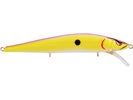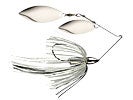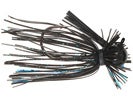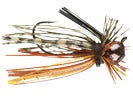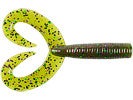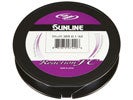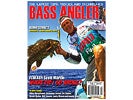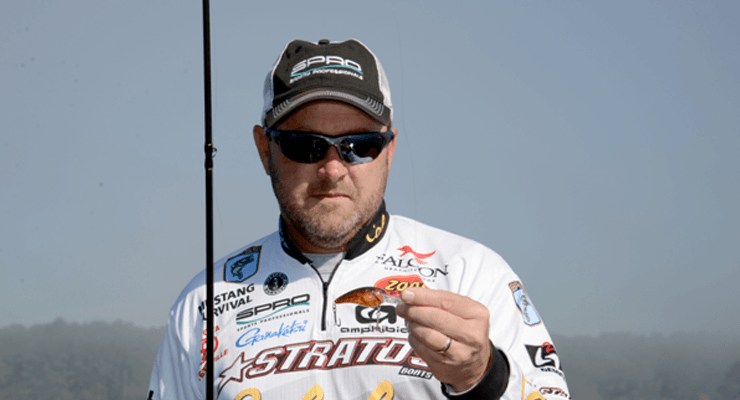
Mike McClelland talks about fall fishing and his approach for catching bass in the fall. The following is Mikes Fab Four for fall bass fishing in his own words. Mike starts with what I consider the fall time fishing is when we get the first true cold fronts, the water temps starting to drop and the baitfish start their migration up into the backs of the creeks. Fall is a very broad season and will depend on the part of the country that you live in, in the north fall may be only a month where in the southern states it may last four months.
Spro McStick Jerkbait:
Look at the transition time that you have to focus on, you have to pay close attention to the bait fish. Keep a close eye on when they move into the creeks and pay special attention to the types of bait that the bass are keying in on. Matching the hatch in the fall is big. What are the bass feeding on? Do you have gizzard shad or threadfin shad, in the north the main food source may be bluegills? One of the biggest keys in the fall is matching the hatch – what the bass are feeding on.
Through the course of the fall when the bass start to get active a McStick is my bait choice. Anytime the bass are chasing bait there is no better time to use a stickbait especially with a little bit of water color and light wind conditions. For me the McStick is a huge player plus they have a size and color for every fishing situation.
On lakes that are relatively clear that have a lot of little minnows hanging out around on the banks is when the McStick 95 is the deal. Early on in my career I like everyone else threw a spinnerbait, but now when the bass will not commit to the spinnerbait I’ll switch to the 95. It is a smaller profile bait that goes back to matching the hatch. On the other hand if I am fishing water that has some color to it and the bass are shallow feeding on Gizzard shad that is prime for a McStick 115. The 115 is a floating bait that I can fish on the flat, over grass or wood and laydowns and covers a lot of water. It’s that bait that you can just pick up and go with. The versatility of that bait is incredible due to the depth range we are talking a bait that can only dive 1 to 3ft and can be adjusted to be at different depth in the water column by changing the line size. Those two baits are big when the bass are feeding on shad.
War Eagle Spinnerbait:
On big wind or cloudy days I will switch up and grab a spinnerbait. Typically in the fall I am always throwing a double willow leaf combination; that variation can be a 4 to a 4.5 willow leaf combination and it will be a shad color pattern skirt. On a clearer body of water I am going to throw a more translucent color shirt like the color I refer to as mouse or glimmer shad skirts. If you get into dingier color water to make the bait more visible I will go to the whites and the whites and chartreuse to give the bass a better ability to see the bait.
Blade combinations again is forage based, the bigger the bait the bigger the blades on my spinnerbait. If I am fishing a body of water that has gizzard shad I will be throwing the 4.5 and 5 size blades, when the food base is little thereadfin shad or the smaller shore minnow I will down size my blade size. My got-to spinnerbait is the 1/2oz War Eagle Screaming Eagle this is always tied onto during the fall. It’s a bait that is compact and the smaller blades help match the hatch, and really imitates the threadfin and smaller shore minnows. These are the three combinations that I keep in mind with my spinnerbait fishing.
The thing that you really have to keep in mind when throwing a spinnerbait is the weight of the bait, most of the time it will be a 1/2oz War Eagle Screaming Eagle but on an occasion I will throw when needed a 3/8oz spinnerbait to match the size of the forage.
As far as the line I am many times throwing 16lb to 20lb Reaction FC; you are moving the bait, you are waking the bait, and you are keeping it moving in the fall. Line size is not that big of a deal other than hooking the bass in the cover you are fishing and getting the bass over the side of the boat. Typically I use a 7ft to 7’6″ rod that has a lighter tip. I have two different rods that I use for spinnerbait fishing. What rod I use depends on the size of the spinnerbait that I am throwing. Reel speed will always be a 7:3-1 high speed reel. You want to be able to move the bait fast, you want to be able to bring the bait to the surface and wake it and budge it.
Spro Rock Crawler Crankbait:
Another bait that I will work into the fall allot will be the Rock Crawler. Typically when the water temp start to fall into the mid to lower 60s and falling off into the 50’s is when the Spro Rock Crawler will shine. During this time of the season it is almost a reverse of the spring, the bass will start to go to the same types of banks in the fall that they did in the spring. You can catch them on the flat gravel chunk rock points, and they will get back to the backs of the bays following the channel swings. The Rock Crawler is just a bait that you can cover so much water and fish at so many depth ranges, you can throw it up on the flat gravel rock points and just grind it out or you can get up on the channel swings and hit the ledges and out cropping of rocks or sheer bluff rock walls.
As far as a reel I will throw the Rock Crawler in the spring on a 5:4-1 speed reel, but in the fall I will throw the Rock Crawler on a 6:3-1 gear ratio reel, and line sizes will stay the same as spring conditions the deeper I need the bait to go the smaller the line size the higher I need the bait up in the water column the larger the line size will be. Key here is you want to keep the bait grinding and making contact with the cover, you want to fish the proper size line to get the job done with the conditions that you are faced with.
Bass X-Jig:
When it comes to fishing a jig in the fall there are a couple of different things that can actually be a player. Before the thermocline breaks, use the thermocline as the typical depth range to fish the jig in the early fall. Generally early in the fall you will be throwing a football jig. The football jig gives you a smaller compact look and is one of the best jigs to use in early fall. It’s important to maintain contact with the bottom; I am throwing a 5/8oz – 3/4oz to a 1oz jig keeping it on the bottom. Most of the time I will tip this with a spider type skirt I want a compact look to the jig with a twin style tail trailer.
The other thing that comes into play is when these fish start chasing bait and they get up on the bank, there comes a time when I think they get tiered of feeding on shad and start to target crawfish as a food source again. Anywhere where you were fishing a stickbait, spinner bait or Rock Crawler you can go through these areas and fish a jig now targeting crawfish as a fall time meal.
The jig that I like to use is a 1/2oz spider skirted ball head jig a Bass X – spider skirted jig. Most times a brown or green pumpkin jig is best but I will throw black and blue in dingy water conditions from time to time. The 1/2oz round headed jig is my number one choice when fishing rocks and especially around docks. Docks in the fall can be a top area to find bass when you can see that there is food in the area. Using a 1/2oz ball head jig is a top technique to use in the Midwest and has been a main stay for many years, it is one of those things that if you do not have a 1/2oz ball head jig tied on in the fall and fishing it you are missing the boat”.
Click Link To Shop: Bass Angler Magazine
Mike McClelland’s Fall Fab Four For Fall Time Bass Fall2015 Bass Angler Magazine (Scott M. Petersen pg. 24 -26)
- 8 colors available
- 7 colors available
- 7 colors available
- 10 colors available
- 7 colors available
- 16 colors available
- 21 colors available
- 17 colors available
- 1 colors available


